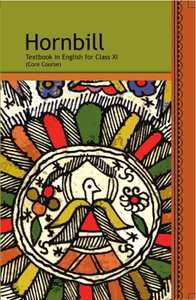Advertisements
Chapters
1.2: A Photograph
2: We’re Not Afraid to Die... if We Can All Be Together
3.1: Discovering Tut: the Saga Continues
3.2: The Laburnum Top
4.1: Landscape of the Soul
4.2: The Voice of the Rain
5: The Ailing Planet: the Green Movement’s Role
6.1: The Browning Version
6.2: Childhood
7: The Adventure
8.1: Silk Road
8.2: Father to Son
9: Note-making
10: Summarising
11: Sub-titling
12: Essay-writing
13: Letter-writing
14: Creative Writing

Advertisements
Solutions for Chapter 1.1: The Portrait of a Lady
Below listed, you can find solutions for Chapter 1.1 of CBSE NCERT for English (Core) - Hornbill.
NCERT solutions for English (Core) - Hornbill 1.1 The Portrait of a Lady Exercise [Page 3]
Notice these expressions in the text. Infer their meaning from the context.
-
the thought was almost revolting
-
an expanse of pure white serenity
-
a turning-point
-
accepted her seclusion with resignation
-
a veritable bedlam of chirrupings
-
frivolous rebukes
-
the sagging skins of the dilapidated drum
NCERT solutions for English (Core) - Hornbill 1.1 The Portrait of a Lady Understanding the text [Pages 6 - 7]
Mention the three phases of the author’s relationship with his grandmother before he left the country to study abroad.
Mention three reasons why the author’s grandmother was disturbed when he started going to the city school.
Mention three ways in which the author’s grandmother spent her days after he grew up.
Mention the odd way in which the author’s grandmother behaved just before she died.
Mention the way in which the sparrows expressed their sorrow when the author’s grandmother died.
NCERT solutions for English (Core) - Hornbill 1.1 The Portrait of a Lady Talking about the text [Page 7]
The author’s grandmother was a religious person. What are the different ways in which we come to know this?
Describe the changing relationship between the author and his grandmother. Did their feelings for each other change?
Would you agree that the author’s grandmother was a person strong in character? If yes, give instances that show this.
Have you known someone like the author’s grandmother? Do you feel the same sense of loss with regard to someone whom you have loved and lost?
NCERT solutions for English (Core) - Hornbill 1.1 The Portrait of a Lady Thinking About Language [Page 7]
Which language do you think the author and his grandmother used while talking to each other?
Which language do you use to talk to elderly relatives in your family?
How would you say ‘a dilapidated drum’ in your language?
Can you think of a song or a poem in your language that talks of homecoming?
NCERT solutions for English (Core) - Hornbill 1.1 The Portrait of a Lady Working with words [Pages 7 - 8]
Notice the following uses of the word ‘tell’ in the text.
1. Her fingers were busy telling the beads of her rosary.
2. I would tell her English words and little things about Western science and learning.
3. At her age, one could never tell.
4. She told us that her end was near.
Given below are four different senses of the word ‘tell’. Match the meanings to the uses listed above.
1. make something known to someone in spoken or written words
2. count while reciting
3. be sure
4. give information to somebody
Notice the different senses of the word ‘take’.
1. to take to something: to begin to do something as a habit
2. to take ill: to suddenly become ill
Locate these phrases in the text and notice the way they are used.
The word ‘hobble’ means to walk with difficulty because the legs and feet are in bad condition.
Tick the words in the box below that also refer to a manner of walking.
|
haggle |
shuffle |
stride |
ride |
waddle |
|
wriggle |
paddle |
swagger |
trudge |
slog |
NCERT solutions for English (Core) - Hornbill 1.1 The Portrait of a Lady Things to do [Page 9]
Talk with your family members about elderly people who you have been intimately connected with and who are not there with you now.
Write a short description of someone you liked a lot.
Solutions for 1.1: The Portrait of a Lady

NCERT solutions for English (Core) - Hornbill chapter 1.1 - The Portrait of a Lady
Shaalaa.com has the CBSE Mathematics English (Core) - Hornbill CBSE solutions in a manner that help students grasp basic concepts better and faster. The detailed, step-by-step solutions will help you understand the concepts better and clarify any confusion. NCERT solutions for Mathematics English (Core) - Hornbill CBSE 1.1 (The Portrait of a Lady) include all questions with answers and detailed explanations. This will clear students' doubts about questions and improve their application skills while preparing for board exams.
Further, we at Shaalaa.com provide such solutions so students can prepare for written exams. NCERT textbook solutions can be a core help for self-study and provide excellent self-help guidance for students.
Concepts covered in English (Core) - Hornbill chapter 1.1 The Portrait of a Lady are Writing Skills, Grammar, Literature Textbook and Extended Reading Text, Reading Skills.
Using NCERT English (Core) - Hornbill solutions The Portrait of a Lady exercise by students is an easy way to prepare for the exams, as they involve solutions arranged chapter-wise and also page-wise. The questions involved in NCERT Solutions are essential questions that can be asked in the final exam. Maximum CBSE English (Core) - Hornbill students prefer NCERT Textbook Solutions to score more in exams.
Get the free view of Chapter 1.1, The Portrait of a Lady English (Core) - Hornbill additional questions for Mathematics English (Core) - Hornbill CBSE, and you can use Shaalaa.com to keep it handy for your exam preparation.
